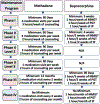Characteristics of patients undergoing medication-assisted -treatment for opioid use disorder and their interest in Tai Chi practice
- PMID: 37644791
- PMCID: PMC10913153
- DOI: 10.5055/jom.2023.0790
Characteristics of patients undergoing medication-assisted -treatment for opioid use disorder and their interest in Tai Chi practice
Abstract
Objectives: (1) To explore the characteristics of patients with opioid use disorder (OUD) maintained on either methadone or buprenorphine and (2) to determine the relative acceptability of integrating Tai Chi (TC) practice into an ongoing medication-assisted treatment for opioid use disorder (MOUD) program.
Design: Survey study.
Setting: The University of Arkansas for Medical Sciences Center for Addiction Services and Treatment Program.
Patients: 97 patients receiving MOUD treatment.
Main outcomes: Drug use history, treatment status, physical limitation, mental health, pain, and whether participants were interested in using TC to improve health outcomes.
Results: At least 30.9 percent of the sample reported moderate or higher level of limitation in performing rigorous physical activities, pain intensity, and pain interference. Between 37.1 and 61.5 percent of the sample reported various psychiatric symptoms. Methadone patients reported higher levels of physical limitations, especially in rigorous activities (p = .012), climbing several flights of stairs (p = .001), and walking more than a mile (p = .011), but similar levels of pain (ps = .664-.689) and psychiatric symptoms (ps = .262-.879) relative to buprenorphine patients. At least 40.2 percent of participants expressed moderate or higher level of interest in TC for improving health outcomes, with methadone patients more interested in participating to ease mental and sleep problems (p = .005) and improve physical fitness (p = .015) compared to buprenorphine patients.
Conclusions: High prevalence of physical limitation, pain, and psychiatric comorbidities were found in OUD patients. Since patients were interested in TC to improve their health outcomes, this low-cost intervention, if proven effective, can be integrated into ongoing MOUD programs to improve health in this population.
Figures
References
-
- Substance Abuse Center for Behavioral Health Statistics and Quality. Results from the 2020 National Survey on Drug Use and Health: detailed tables. Substance Abuse Center for Behavioral Health Statistics and Quality. June 3, 2022. Accessed June 3, 2022. https://nida.nih.gov/download/21349/medications-to-treat-opioid-use-diso...
-
- Council of Economic Advisers, The Underestimated Cost of the Opioid Crisis, E.O.o.t.P.o.t.U. States, Editor. 2017, Executive Office of the President of the United States: Washington, DC.
-
- Hedegaard H, Miniño AM, Warner M. Drug Overdose Deaths in the United States, 1999–2017. NCHS Data Brief. 2018;(329):1–8. - PubMed
-
- Saxon AJ, McCance-Katz EF. Some Additional Considerations Regarding the American Society of Addiction Medicine National Practice Guideline for the Use of Medications in the Treatment of Addiction Involving Opioid Use. J Addict Med. May–Jun 2016;10(3):140–2. doi:10.1097/ADM.0000000000000219 - DOI - PubMed
MeSH terms
Substances
Grants and funding
LinkOut - more resources
Full Text Sources
Medical


